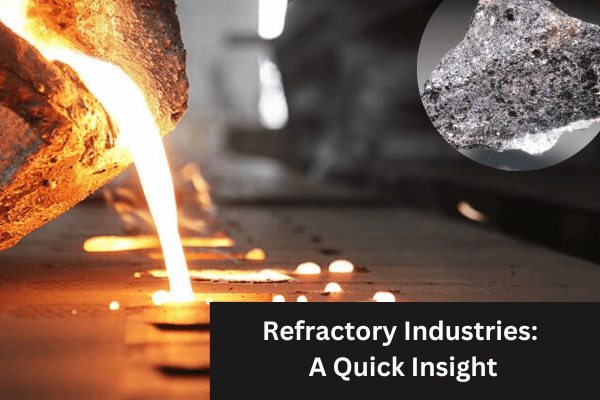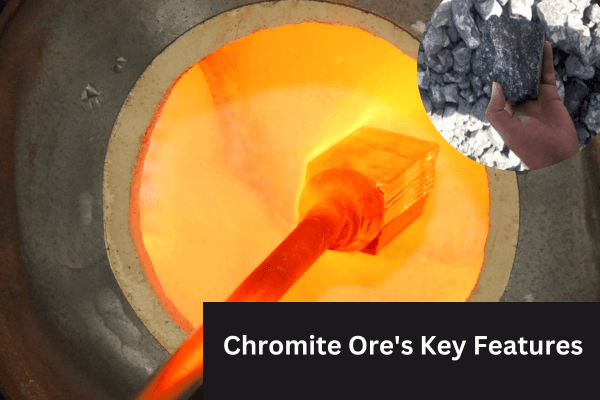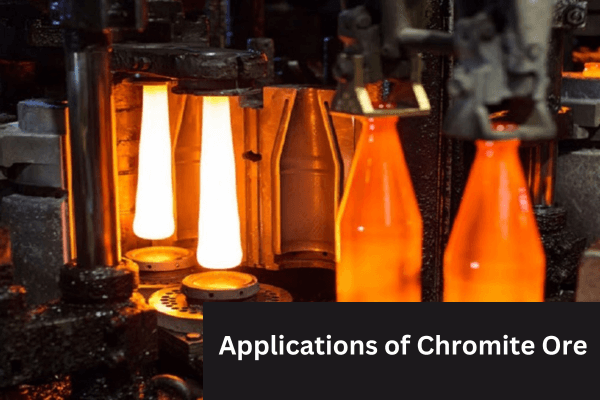Role of Chromite Ore in Refractory Industries: An Extensive Overview
Introduction:Role of Chromite Ore in Refractory Industries
Chromite ore, for those not familiar, is a dark brown to black mineral that’s primarily composed of iron chromium oxide, possessing a spinel structure.It’s a cornerstone in the production of ferrochrome – a key ingredient in the production of stainless steel.
The refractory industry, for those out of the loop, is all about materials that can withstand incredibly high temperatures without melting. Think of the insides of a blast furnace or a kiln. That’s where refractories come into play. Chromite, due to its high melting point and strong resistance to thermal shock, is a preferred material in the refractory industry. In this article, Iran Chromite, explores the role of Chromite in refractory industries:

Refractory Industries: A Quick Insight
What are refractory materials?
Okay, picture this. You’ve got this massive furnace, flames roaring and all, but you can’t just have those flames dancing around any old material. You’d have a meltdown on your hands! That’s where refractory materials come in. These are designed specifically to bear extreme heat and pressure without melting away. They’re made from natural and synthetic materials that don’t decompose easily—even under intense heat.
The crucial role of refractory materials in various industries
Alright, so why all the fuss about these refractory materials, right? Well, here’s the thing. Industries like steel, cement, and glass would be in a real pickle without them. Imagine trying to mold molten metal or produce high-quality glass without a reliable material to hold all that fiery fury. It’d be a disaster!
In the steel industry, for instance, refractory materials are essential for lining blast furnaces, ladles, and tundishes. These materials protect the machinery and ensure that the molten steel doesn’t escape and cause a catastrophic event.
In the glass industry—another one that’s close to my heart—the refractory materials play a starring role in the glass melting process. Without them, the glass would react with the container, leading to all sorts of impurities.
And, the cement industry! Refractory materials line the rotary kilns, making sure the production process runs as smoothly as butter on a hot skillet.

Chromite Ore’s Key Features Beneficial to Refractory Industries
High melting point and stability
Chromite ore boasts a remarkably high melting point. This makes it a darling in refractory applications. With its incredible stability at elevated temperatures, it doesn’t degrade or melt away like our poor marshmallows. Imagine the stability of a mountain – that’s what chromite ore brings to the table, ensuring furnaces and kilns maintain their integrity.
Resistance to thermal shock
Whoa, let me tell you – if there’s one thing chromite ore is known for, besides its fantastic stability, it’s its resistance to thermal shock. You know how glass cracks if you pour boiling water into it from the freezer? That’s a reaction to sudden temperature changes, a.k.a thermal shock. Chromite’s resistance to this phenomenon is simply astounding! It’s like putting on a coat in winter and feeling nothing but warmth. It can withstand rapid temperature fluctuations without losing its cool (pun intended) – a trait highly treasured in refractory materials.
Compatibility with various bonding agents
And don’t even get me started on chromite ore’s compatibility with bonding agents. Throughout my experiences in the mining industry, I’ve noticed that this compatibility makes chromite invaluable. Whether it’s clay, graphite, or any other binder, chromite mingles effortlessly. This ensures the refractories have a solid structure and remain cohesive even under extreme conditions. It’s like that dependable friend who’s always got your back, rain or shine.
Different Types of Chromite Refractories
The world beneath our feet, quite literally, is bursting with this incredible ore, and its application is, well, extensive. So, let’s dive in, shall we?
Direct-bonded chromite refractories
Now, when we talk about direct-bonded chromite refractories, we’re discussing materials where chromite grains are stuck directly to each other. Think of it as puzzle pieces fitting together seamlessly. This bonding provides high strength, and guess what? These refractories can withstand incredibly high temperatures without melting – I’ve seen it, and it’s nothing short of astonishing. But there’s a catch – they’re vulnerable to certain corrosive environments, something I’ve had to deal with time and again. So, while they’re great for some uses, one must tread with caution in specific scenarios.
Semi-rebonded and fully rebonded chromite refractories
Alright, let’s chat about the semi-rebonded and fully rebonded types. These refractories are a bit different. They contain both raw chromite grains and grains bonded with silica. In semi-rebonded, you’ll find a mix of directly bonded chromite and silica-chromite bond, whereas fully rebonded is just what it sounds like – all grains are rebonded with silica. It’s a fascinating process, and the result? You get refractories that have enhanced resistance against corrosion. I can’t tell you how many times I’ve recommended these to folks dealing with harsh environments.
Fused cast chromite refractories
Lastly, let me touch upon fused cast chromite refractories. These bad boys are created by melting the chromite with the help of an electric arc furnace and then casting it. It’s like watching magic – seeing the molten ore transform! These refractories have superb corrosion resistance and mechanical strength. And the best part? They’re pretty consistent in terms of their structure, which can be a real game-changer in many applications.
Advantages of Chromite-Based Refractories Over Other Refractories
Enhanced corrosion resistance
First and foremost, the corrosion resistance! These refractories exhibit an impressive ability to resist the nasty effects of slags and other corrosive elements they’re exposed to in high-temperature environments. You know, when I chat with other industry pros, they always nod in agreement – chromite’s resistance is top-notch!
Increased lifespan and durability
Now, onto the durability factor. Over the past decade, I’ve seen countless industries struggling with frequent replacements due to wear and tear. But here’s the kicker: chromite refractories have this uncanny ability to last longer, and I mean way longer than most. It’s not just about surviving high temperatures; it’s also about standing up to the physical demands of industrial processes.
Cost-effectiveness in long-term industrial processes
While there might be a slightly higher initial investment, the longevity and reduced maintenance of chromite refractories make them cost-effective in the long run. I mean, think about it – fewer replacements, less downtime, and reduced wear-related losses. That’s some serious savings over time! Every penny saved is a penny earned, right? And in the industrial world, these pennies quickly add up to big bucks.

Applications of Chromite Ore in Refractory Industries
Steel and metallurgy; It’s undeniable how vital chromite ore is in the production of stainless steel. Why, you ask? Well, chromite is a primary source of chromium, which, when added to steel, gives it that shiny, rust-resistant quality we all love and need. From kitchen sinks to architectural marvels – without chromium, we’d be dealing with rusty infrastructures.
Glassmaking industries; Another intriguing field where chromite plays a pivotal role. Its remarkable heat-resistant properties make it a choice material in the production of special types of glass – especially the ones that need to withstand high temperatures. I’ve seen first-hand how the glass industry depends on chromite to produce molds and other refractory products. It’s truly mind-blowing how a single mineral can have such varied and significant applications!
Cement and rotary kilns Now, onto the world of cement. We’ve all seen those massive rotary kilns, right? They’re responsible for producing cement. And guess what? Chromite’s high melting point and stable crystalline structure make it an invaluable part of the refractory lining in these kilns.
Power plants and incinerators Last but certainly not least, power plants and incinerators. These places deal with incredibly high temperatures – I mean, we’re talking molten lava levels! Chromite, with its exceptional thermal conductivity and stability, is used in the linings of furnaces and other high-temperature equipment. It ensures these machines last longer and operate more efficiently.
Conclusion:Role of Chromite Ore in Refractory Industries
Diving deep into the world of Chromite Ore in the refractory industry sure is an eye-opener. From the insides of mammoth furnaces to the very glass we use daily, the omnipresence of chromite is undeniable. It’s humbling to recognize the unsung hero – Chromite, which, in many ways, is the backbone of so many industries. In this article, we explored how valuable the role of chromite ore in refractory industries is. If you need further information about chromite ore and how to supply it from Iranian miners, contact our support.
